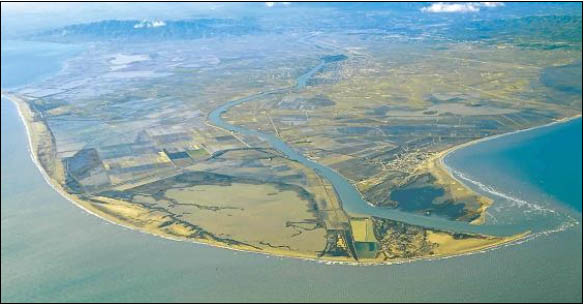| Ebro Delta - Spain |
| Complete description
of case study |
PHOTO OF THE SITE
|
|
 |
|
CASE STUDY
| Title | Ebro Delta |
| National level | Spain |
| Regional level | Catalunya Autonoumous Community, Tarragona province |
| Local level | Amposta |
ABSTRACT
|
The Ebro Delta is located in the northeast coast of Spain, in the province of Tarragona. It represents the main coastal delta of the Iberian Peninsula and one of most important of the Mediterranean. Morphologically it presents a deltaic front, in which locates the present mouth of the Ebro River and two spits that partially close the Fangar and Alfacs lagoons, located north and south respectively. The spit of El Trabucador, that shows an approximated width of 250m and 6km long, is closing the bay of Els Alfacs in the south. The coast length is of about 50km and presents an emerged area of 325km2. The predominant wave directions are North, South and East, which produce sediment transport towards the northern and southern hemideltas. The morphologic configuration of the Ebro Delta causes the existence of zones with different behavior with respect to coastal dynamics, alternating beaches with erosive character (river mouth, Marques and Pal beaches and Trabucador Spit) with beaches whose tendency is accretion (Fangar Spit, Alfacs Spit and Eucalyptuses Beach). Other factor that affect their erosion is the river damming. The Ebro Delta presents exceptional values of natural heritage. Represents the second more important aquatic habitat of the western Mediterranean, after the French Camarga. Its low altitude causes a high vulnerability to erosion putting in danger all these values of difficult economic assessment. At the moment,
the performances in the deltaic coast are marked by the presence of the
Natural Park of the Ebro Delta. Thus, the actions of coastal engineering
have gone fundamentally to the preservation and recovery of the environment,
trying to palliate and/or to diminish the impacts of hard engineering
measures. The performances will have to be directed to the integration
of the natural and human aspects, using criteria of sustainable development,
that allows to make compatible the different uses of the delta (fishing,
agriculture, extraction of salt, tourism) with natural and unique ecosystems
from biodiversity (flora and fauna). |
BASIC INFORMATION
| Coastal characteristics |
|
| Policy options | Hold the line, Do nothing, managed realignment |
| Socio-economic activities | Natural park, agriculture, fishery, aquiculture, hunting, industry (salt), tourism |
| Engineering techniques | Dune nourishment, wind traps, revegetation, beach drainage |
SOURCE
| Name | Inmaculada Rodríguez Santalla |
| Institution |
Universidad Rey Juan Carlos Escuela Superior de Ciencias Experimentales y Tecnología |
| Address | C/
Tulipán, s/n; 28933 Móstoles Madrid (Spain) |
| Telephone / fax | +34 91 488 70 17 / +34 91 488 74 90 |